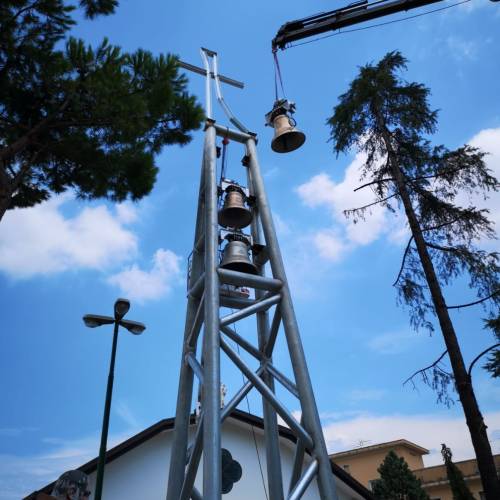Bronze bells
Metal, Bronze
The construction of the bells
Maintaining fidelity to the origins is, in the merger of a bell, an indisputable prerogative of the company. The manufacturing process has remained unchanged and still entrusted to skilled craftsmen who perform it as if it were a ritual. This allows us to create single bells and concertos that are perfect for chord and harmony in the order of a sixteenth of a tone. The first operation is the construction of a clay brick core which is covered with a layer of clay called a false bell and which forms its internal profile. On its surface, well polished, wax is applied, on which captions, inscriptions, etc. are engraved. The surface is covered with a further layer of clay which constitutes the mantle or shirt of the bell. Finally, the cooking is performed, defined as lost wax, by burning charcoal inside the core; once the wax has melted, the negative inscriptions will remain impressed on the shirt, which can be lifted and placed on the brick core once the false bell has been destroyed.
In the cavity that will be formed, molten bronze will be poured at a temperature of 1150/1200 ° C. The metal is filtered with special fine ceramic filters that have been designed to obtain quality castings. Some of the most important requirements of the filters are the mechanical seal for the benefit of safety and the honeycomb filter structure which has a considerable filtering power. According to the law of fluid mechanics, the molten metal, forced into small section transit ports, falls in a swirling motion favoring the separation of solid particles which, by attraction, will adhere to the internal surface of the transit and will not obstruct the original section. The most suitable location to protect clean metal from contamination is at the entrance of the mold.
The metal will cool very slowly, giving life to the bell. Once the mold has been broken, to make each bell a unique piece, the bell will be ready for finishing and for musical testing.
Maintaining fidelity to the origins is, in the merger of a bell, an indisputable prerogative of the company. The manufacturing process has remained unchanged and still entrusted to skilled craftsmen who perform it as if it were a ritual. This allows us to create single bells and concertos that are perfect for chord and harmony in the order of a sixteenth of a tone. The first operation is the construction of a clay brick core which is covered with a layer of clay called a false bell and which forms its internal profile. On its surface, well polished, wax is applied, on which captions, inscriptions, etc. are engraved. The surface is covered with a further layer of clay which constitutes the mantle or shirt of the bell. Finally, the cooking is performed, defined as lost wax, by burning charcoal inside the core; once the wax has melted, the negative inscriptions will remain impressed on the shirt, which can be lifted and placed on the brick core once the false bell has been destroyed.
In the cavity that will be formed, molten bronze will be poured at a temperature of 1150/1200 ° C. The metal is filtered with special fine ceramic filters that have been designed to obtain quality castings. Some of the most important requirements of the filters are the mechanical seal for the benefit of safety and the honeycomb filter structure which has a considerable filtering power. According to the law of fluid mechanics, the molten metal, forced into small section transit ports, falls in a swirling motion favoring the separation of solid particles which, by attraction, will adhere to the internal surface of the transit and will not obstruct the original section. The most suitable location to protect clean metal from contamination is at the entrance of the mold.
The metal will cool very slowly, giving life to the bell. Once the mold has been broken, to make each bell a unique piece, the bell will be ready for finishing and for musical testing.
- Material
- Metal, Bronze









